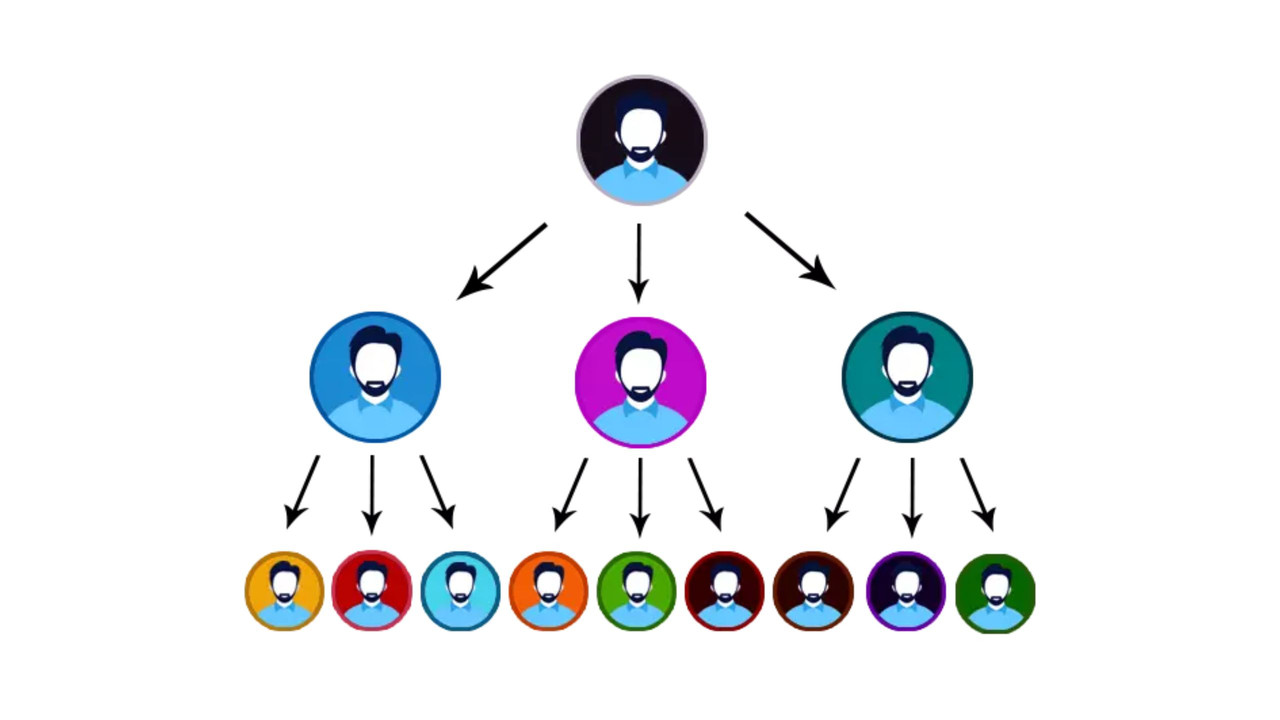What Is MLM (Multi-Level Marketing) Software
MLM (Multi-Level Marketing) software is a specialized application designed to facilitate and manage the operations of multi-level marketing businesses. Multi-level marketing, also known as network marketing or direct selling, is a business model where products or services are distributed through a network of independent distributors or representatives. These distributors earn commission not only from their direct sales but also from the sales made by the distributors recruited into the network, thereby creating a MLM compensation structure.
What is direct selling?
Direct selling, also known as MLM (Multi-Level Marketing) or Network marketing is a method of retailing any kind of products or services through D2C Model, outside of a traditional brick & mortar retail setting. In this kind of business models, individuals act as independent distributors for companies and earn very good income by selling their products directly to recruiting others to join the distribution network as fellow distributors.
Advantages of using an MLM Software
If you using MLM software offers several advantages for businesses operating in the MLM (multi-level marketing) industry.
Here Are Some Key Points for Using MLM Software
Efficient Management: MLM software automates various processes including member registration, product sales tracking, and commission calculation and reporting. It streamlines administrative tasks, reduces manual errors and improves overall operational efficiency.
Scalability: MLM software is designed to handle large networks and accommodate the growth of your MLM business. It can manage a large number of distributors, track their sales volume, and accurately calculate commissions regardless of network size.
Member engagement and support: The MLM software provides communication tools, such as messaging systems and notifications, to facilitate effective communication between the company and its distributors. It helps keep distributors informed about updates, promotions and important announcements, boost member engagement and support.
Time and cost savings: By automating repetitive tasks and streamlining processes, MLM software saves time and reduces the administrative burden on the company and its distributors. It eliminates the need for manual calculation, data entry and paperwork, resulting in cost savings and increased productivity.
Types of MLM Plans
Binary MLM plan
The Binary MLM plan is a popular compensation structure used in MLM or Network Marketing businesses. It is named "Binary" because of its two-leg structure, where each distributor is allowed to have only two frontline distributors.One on the left leg and the other on the right leg. Any additional recruits are placed under existing distributors, forming a tree-like structure.
Some Key Features of the Binary MLM Plan
2 Legs Plan: The Binary MLM plan consists of 2 legs only a left leg and a right leg for each distributor. These legs represent the distributor's downline organization.
In Power Leg and Weak Leg: In the Binary plan, one leg is known as the "Power Leg," which is the leg with more sales volume or more recruits. The other leg is called the "Weak Leg." The commission is typically calculated based on the sales volume of the weaker leg, encouraging distributors to balance their efforts in recruiting and sales between both legs.
Commission Calculation: Commissions in the Binary MLM plan are usually calculated based on a specific percentage of the sales volume of the weaker leg. Some companies may also offer additional bonuses or incentives for achieving certain milestones, such as matching bonuses for helping their downline distributors earn commissions.
Carry-Forward: Some Binary plans allow for carry-forward of sales volume or unused commissions from one accounting period to the next, ensuring that distributors have a chance to maximize their earnings.
Here Some Advantages of the Binary MLM plan:
Simplicity: The Binary plan is relatively easy to understand, making it more appealing to new distributors joining the MLM business.
Teamwork: The Binary plan promotes teamwork and cooperation among distributors, as they work together to balance the legs and support each other's success.
Unilevel MLM plan
Unilevel MLM plan is one of the most popular structures used by MLM companies. In this plan, affiliates are compensated based on their sales performance as well as the sales performance of their downline, typically extending to a limited number of levels deep. Its called "uni-level" because there is a single level of distributors directly sponsored by each person.

Some Key Features of the Unilevel MLM Plan
Single-level structure: Each distributor can sponsor an unlimited number of frontline distributors directly under them. There is no width restriction, which means you can build a wide frontline.
Limited depth: Compensation is usually paid down to a certain depth, typically limited to a fixed number of levels or generations. For example, a Unilevel plan might pay commissions up to 5 or 7 levels deep.
Commissions based on downline sales: Distributors earn commissions or bonuses based on the product sales made by their downline members up to the specified level or generation depth.
Personal Sales Volume: In a Unilevel MLM plan, distributors often need to achieve a certain level of personal sales volume to be eligible for commissions and bonuses.
Limited width: While there is no limit to the frontline width, some companies might introduce restrictions or incentives to encourage depth-building and avoid excessive width.
Some Advantages of the Unilevel MLM plan:
Easy to understand for affiliates.
Encourages teamwork among downline members.
Typically suits services that have broad consumer appeal.
Matrix MLM plan
Matrix MLM plan, also known as the Forced Matrix plan, is another popular compensation structure used by MLM companies. It is designed to limit the width & depth of the network, creating a structured organization of affiliates. The Matrix plan specifies the maximum number of distributors that can be sponsored on each level, creating a defined matrix structure.

Some Key Points of Matrix MLM Plan
Limited width and depth: Unlike the Unilevel plan, the Matrix plan restricts the number of frontline distributors each member can sponsor. For example, in a 3x3 Matrix plan, each distributor can only sponsor three frontline distributors, and the matrix extends down to three levels deep.
Depth variations: The Matrix plan can have different configurations, such as 2x2, 3x3 etc. depending on the company's design. The numbers represent the width & depth of the matrix.
Commission structure: Distributors earn commissions based on the sales made by their downline members within the limited matrix structure. Different levels of the matrix may offer different commission rates or bonuses.
Forced placement: In some Matrix plans, the company may have rules for placing new affiliates in specific positions within the matrix, which can affect the spillover and spill under dynamics.
Some Advantages of the Matrix MLM plan:
Controlled growth: The limited width and depth allow for better control of the network's growth and can prevent excessive expansion.
Teamwork and support: Since the matrix encourages teamwork, distributors often support and help their downline members to fill their matrix positions.
Stairstep Breakaway MLM plan
The Stair Step Breakaway MLM plan is one of the various compensation structures used by MLM companies to reward their distributors or sales representatives. In this plan, distributors advance through various levels of achievement and qualification, with the ultimate goal of reaching a "breakaway" point where they can lead their own downline team independent of their original upline.

Some Key features of the Stair Step Breakaway plan:
Stair Step Advancement: Distributors progress through different ranks or levels by achieving certain sales or recruitment targets. Each level offers increasing benefits, such as higher commissions, bonuses, and rewards.
Leadership Positions: Once a distributor reaches the breakaway point, they can become a leader and form their own team with its downline. They essentially become an independent entity within the MLM Company.
Override Commissions: As a distributor's downline members progress and achieve sales or recruitment targets, they will also break away, but the original distributor (the breakaway leader) earns override commissions on the sales made by those breakaway groups.
Advantages: The Stair Step Breakaway plan encourages distributors to focus on achieving higher sales and recruitment goals to advance through the ranks. It can lead to rapid growth and expansion of the sales force, and successful leaders can earn substantial override commissions.
Board MLM plan
The Board MLM plan, also known as the Board Plan or Revolving Matrix Plan, is a popular compensation structure used by Multi-Level Marketing (MLM) companies. It is designed to promote teamwork, incentivize recruitment, and foster rapid expansion within the network. This plan typically follows a 2x2 matrix structure, but it can be customized to have different matrix sizes.

Some Key Point of Board MLM plan
Board Structure: In the Board Plan, each distributor can sponsor only two frontline members, forming the first level. These two members then sponsor their two frontline members each, forming the second level, and so on. This creates a matrix-like structure.
Splitting Boards: When a distributor completes a board, they typically receive a reward and are then "split" into two new boards. The distributor will retain one position in the current board and start a new board. The other board will be placed directly under the distributor's original upline.
Continuity: Successful distributors can continuously cycle and receive rewards as long as they keep filling boards and meeting the plan's requirements.
Challenges: The Board Plan may face challenges when the matrix becomes oversaturated or when distributors struggle to recruit new members. This can result in delays in cycling and receiving rewards.
Generation MLM plan
The Generation MLM plan is a popular compensation structure used in multi-level marketing (MLM) companies. It is also known as the "Generation Breakaway" plan. Like other MLM plans, it aims to incentivize distributors to not only sell products but also recruit and train their downline members, creating a network of salespeople.

Here Are Some Key Points For The Generation MLM Plan:
Generation Levels: In this plan, distributors are organized into different "generations" based on their recruitment hierarchy. The original recruiter is considered the first generation, the people they directly recruit are the second generation, and so on. As distributors continue to recruit, each new level forms a new generation.
Commission Structure: Distributors earn commissions based on the sales volume generated by their downline members up to a certain number of generations. Each generation may have different commission rates.
Leadership Overrides: Once a distributor breaks away, they may continue to earn commissions from their former downline's sales as well as additional bonuses based on the sales of the new generations that form within their organization.
Advantages: The Generation MLM plan encourages distributors to mentor and support their downline, as they will benefit from their team's success. The breakaway feature also allows successful distributors to gain more autonomy and potentially higher earnings.
Hybrid MLM plan
Hybrid MLM plan, as the name suggests, is a combination of two or more traditional MLM compensation plans. MLM companies sometimes use hybrid plans to incorporate the advantages of different plans and tailor their compensation structure to suit their specific business needs and goals. This plan can be more complex than single-structure plans, but it offers greater flexibility and can potentially provide better incentives for distributors.

Some Key points of Hybrid MLM plan
Binary Structure: The Binary structure is a common component of the Hybrid MLM plan. In a Binary plan, each distributor can have only two frontline members. Any additional recruits are placed under their existing downline, creating a "spillover" effect. This plan encourages teamwork and helps to build depth in the organization.
Unilevel Structure: The Unilevel structure is another element that can be incorporated into the Hybrid plan. In a Unilevel plan, distributors can sponsor unlimited frontline members, and there are usually no width restrictions. Commissions are paid on multiple levels, allowing for more horizontal growth.
Infinity Bonuses: Some Hybrid MLM plans offer Infinity Bonuses, which means that certain top-level distributors can earn commissions on the sales volume of unlimited levels in their organization. This can be a powerful incentive for building and maintaining a strong team.
Gift MLM Plan
Gift MLM Plan, also known as the Cash Gifting Plan, is a controversial and potentially illegal compensation structure used in some multi-level marketing (MLM) or network marketing programs. It is important to note that many countries have laws and regulations that prohibit or restrict the operation of gift or cash gifting schemes, considering them to be pyramid schemes.

Some Key Points for Gift MLM Plan
Cash Gifting: Participants are typically required to make an upfront cash gift or donation to the person who invited them to join the program. This gift can vary in amount, and the promise of receiving more significant gifts in return is used as an incentive to recruit others.
No Product Sales: Unlike legitimate MLM models, the Gift MLM Plan often lacks actual products or services for sale. The entire focus is on gifting money, making it unsustainable in the long term.
Pyramid Structure: The Gift MLM Plan typically follows a pyramid structure, where new members form the base, and as they recruit others, they move up the pyramid. The participants at the top receive gifts from the larger pool of participants below them.
Party MLM Plan
Party MLM Plan is a variation of the traditional MLM compensation structure, designed to promote and sell products through home parties or social gatherings. This plan is also known as the Party Plan

Some key points of Party MLM Plan works:
Consultant Recruitment: Individuals become consultants by joining the MLM Company and purchasing a starter kit or product package. They are then trained to host parties and sell products effectively.
Party Hosting: Consultants organize and host parties at their homes or the homes of their guests. Alternatively, parties can take place online through virtual events.
Sales and Orders: Guests have the opportunity to place orders for the products they are interested in purchasing. The consultant collects these orders and forwards them to the MLM Company.
Recruiting: Consultants have the option to recruit others to join the MLM Company and become part of their sales team (downline). They earn commissions on the sales generated by their downline members as well.
Crowdfunding
Crowdfunding is a method of raising funds for a project cause by collecting small contributions from a large number of people, typically via the internet. It is serves as an alternative to traditional funding system like bank loans capital investments. Crowdfunding platforms provide a space where organizations can present their projects to a broader audience, who can then decide whether to support the initiative financially.

The process of crowdfunding
Project Creation: The individual or organization seeking funds (the project creator) prepares a detailed description of their project or idea, including its purpose, goals, timeline, and potential rewards or incentives for backers.
Setting a Funding Goal: The project creator sets a specific financial target that they aim to reach within a defined timeframe. This is the minimum amount needed to bring the project to fruition.
Campaign Launch: The project creator launches the crowdfunding campaign on the chosen platform. They promote the campaign through various channels, such as social media, email marketing, and word-of-mouth, to attract potential backers.
Backer Contributions: Individuals who support the project are called backers. Backers can contribute funds in various amounts, depending on the platform's rules and the project creator's reward tiers.
Project Completion: If the campaign is successful and reaches its funding goal, the project creator receives the funds. They are then responsible for implementing the project and delivering any promised rewards to their backers.
Types of Crowdfunding:
Donation-based Crowdfunding
Reward-based Crowdfunding
Equity Crowdfunding
Debt Crowdfunding (Peer-to-Peer Lending)
Final Words:
Here, we are discussing with you what MLM Software is and the types of MLM Plans. If you have any doubts or need to create MLM software, you can contact our team, and we will be glad to assist you.

 +91 9877752948
+91 9877752948
 +44 7942334242
+44 7942334242











0 Comments
Leave a Comment